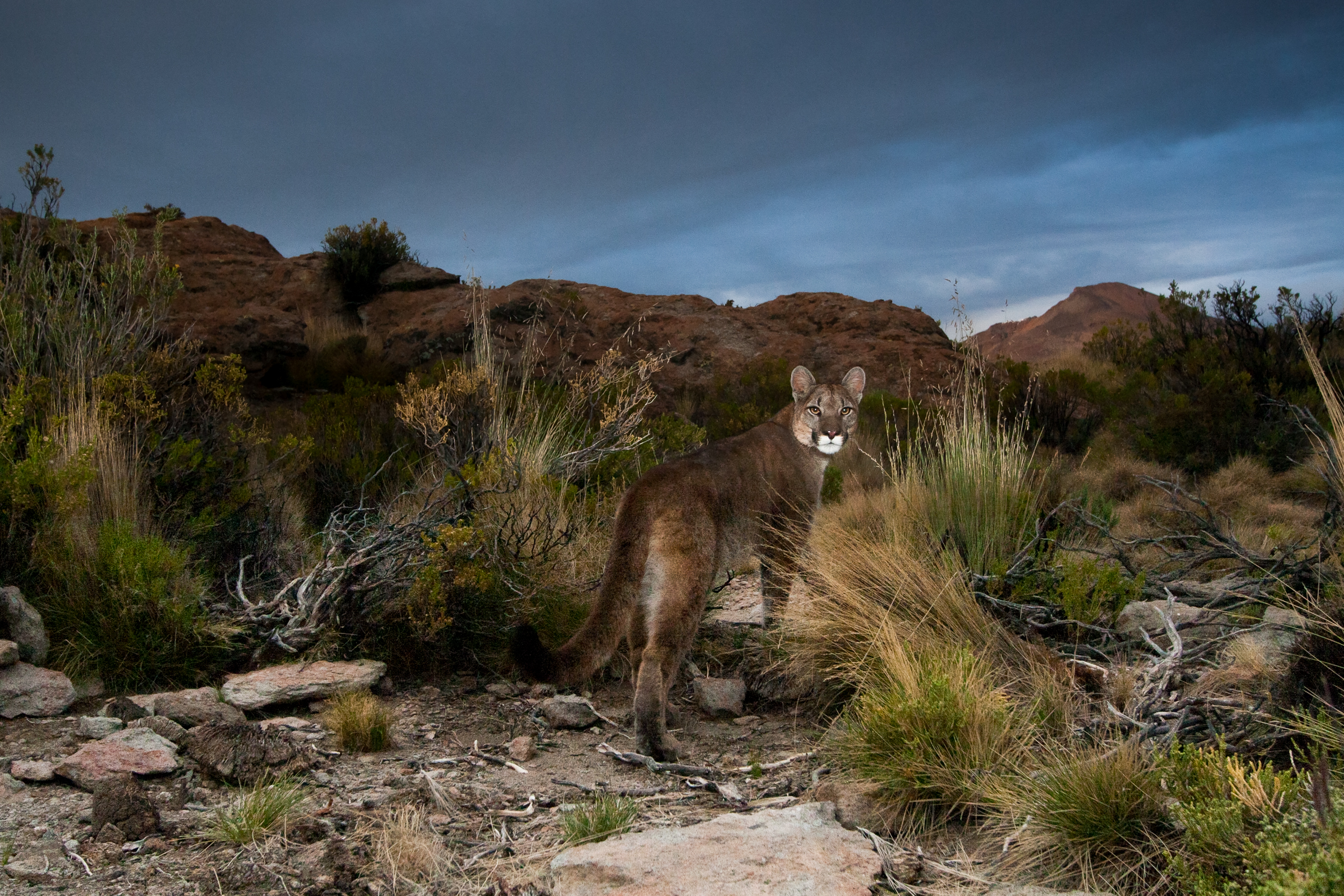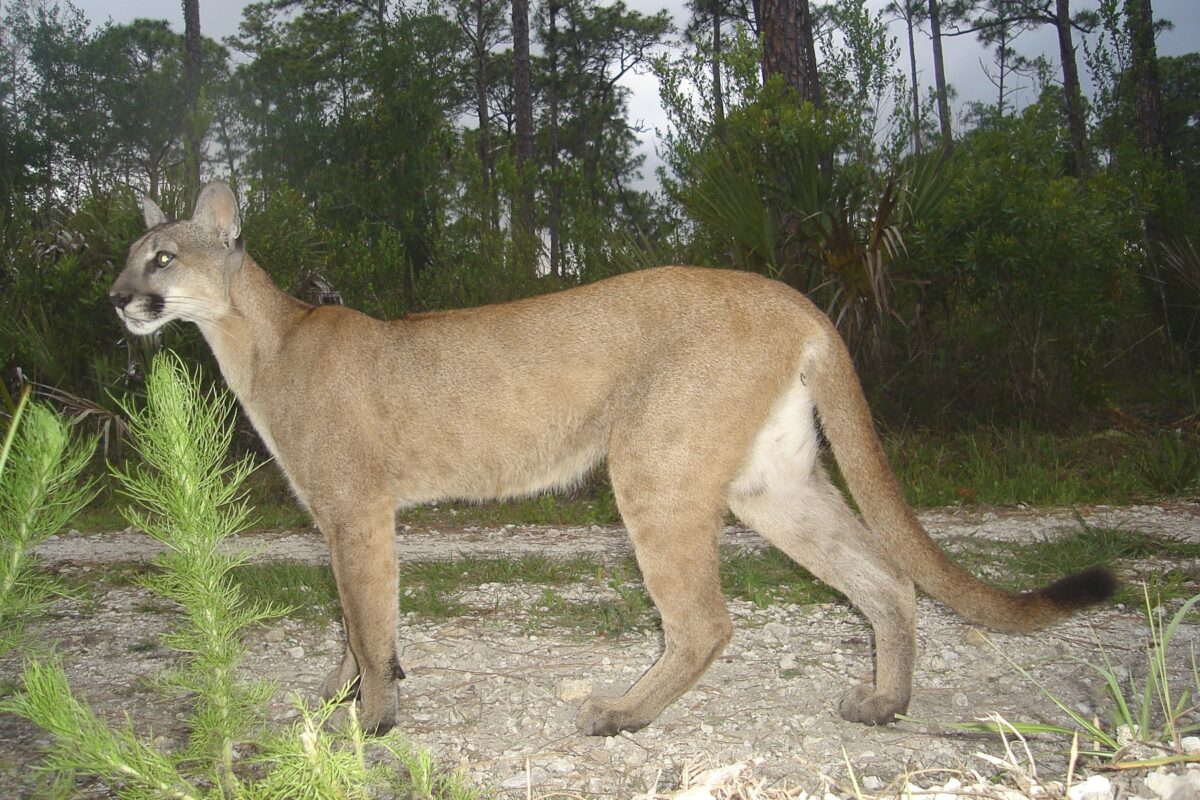
Return of the American Lion? Taking Action May Pave the Way to the Midwest and East
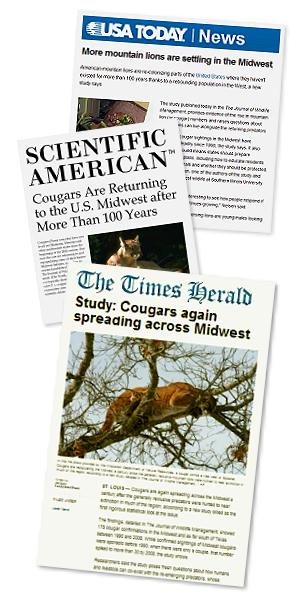
All the hoopla resulted from the release of a single scientific paper which concluded that lions were returning to some Midwestern states. The paper was authored by Ph.D candidate Michelle LaRue and Dr. Clay Nielsen and published by the Journal of Wildlife Management on June 14, 2012. But in their exuberance the press didn’t ask some key questions, such as: how did this come to pass, whether the trend is sustainable, and how was the news received by local policy makers.To address some of these critical questions, the Mountain Lion Foundation looked not only at the LaRue & Nielsen paper but also at two other recent projects: a summary paper from the Cougar Rewilding Foundation(formally the Eastern Cougar Foundation) and a presentation by the U.S. Forest Service’s Rocky Mountain Research Station.
The following is a synopsis of these three important scientific reports and MLF’s conclusions on what this might portend for the eastern return of Puma concolor.
The LaRue/Nielsen Paper
Between 1990 and 2008, 178 confirmed lion sightings were recorded by researchers and state wildlife agencies throughout the Midwest, the East, and parts of Canada. In June 2012, Ph.D candidate Michelle LaRue and Dr. Clay Nielsen published a paper in the Journal of Wildlife Management analyzing those sightings.
Their conclusions are that sightings of mountain lions have become more common in the region over recent years and it appears that lions prefer to stay close to their traditional habitat (woodland forests, riverine corridors and steep or broken terrain) since 79 percent of all confirmed sighting occurred within 50 kilometers of such terrain.
LaRue’s team also validated the current understanding that young male lions tend to travel farther than female lions. When evidence was available that allowed the researchers to determine sex (carcasses, tissue samples), 76 percent of the samples were found to belong to male lions.
Ultimately the paper concluded that, “Given the number of cougar confirmations, the increasing frequency of occurrences and that long-distance dispersal has been documented via radio-collared individuals, our research suggests that cougars are continuing to recolonize Midwestern North America.”
Cougar Rewilding Foundation Report
The Cougar Rewilding Foundation (CRF) featured a report in their June 2012 newsletter titled Cougar Mortalities in Central North America and the Evidence Against Recolonization East of the Prairie Colonies. The publication reviewed data from the years 2000 through June of 2012. Based on this information, CRF reached a different assessment of the future for lions in the Midwest.
CRF’s report posits that sightings alone are unreliable in determining a number for how many lions are actually in the Midwest. Along its journey, a single lion will leave hundreds of signs (tracks, scat, cached prey, hair samples, etc.) and may result in dozens of samples submitted to researchers. These duplicate accounts are misleading and without DNA analysis to identify individuals, the number of transient Midwest lions may be drastically inflated.
CRF also believes the increase in sightings isn’t the result of anything new, but instead is a response to something started decades ago when western game managers started regulating the killing of lions. Now, 40 years later, lions have dispersed “from and breed in island habitats east of the Rockies. To date, there are five recolonized areas within 160 miles of the Eastern Front.”
CRF’s report agrees with the evidence that young male lions are traveling long distances looking for mates, but takes this as evidence that true recolonization (breeding pairs, not just long treks by males) is a slow process of incremental advances. “It took twenty years of dispersal from the Back Hills to establish a breeding colony 100 miles to the southeast in the Nebraska Pine Ridge. At that rate, under good conditions, breeding may not occur in Minnesota before 2050, let alone further east.”
The report also noted that current lion hunting policies in “breeder” states could threaten forty years of species recovery and stop the eastern expansion of the species.

The Rocky Mountain Research Station DNA Project
In May 2012, the U.S. Forest Service’s Rocky Mountain Research Station (RMRS)presented the results of their recent DNA analysis of cougar sightings in the Midwest, specifically focusing on the increased number of reports in Missouri.
Prior to their research it had been assumed that the lions reaching Missouri had come from Texas by following what is known as “least-cost pathways” or the preferred habitats and the easiest landscapes for lions to traverse. However, when RMRS matched their DNA samples with known population characteristics in western states, the results showed that lions were actually dispersing from different areas than those predicted. Though a portion may have used known least-cost pathways, when it came to the lions in Missouri, they originated almost exclusively from the Black Hills region of South Dakota.
Rocky Mountain Research Station researchers also addressed the sighting/number issue by reviewing the boom in cougar sightings in Wisconsin in 2010.
In just a six month period there were over a dozen confirmed reports of lions from all over the state. Some hunters and nervous ranchers began campaigning to allow a hunting season on the population of cats that appeared to have exploded over night.
After careful analysis by the RMRS on hair and scat samples collected at sighting locations, the results came back that all these reports were of the same, solitary individual lion. This one lion had wandered the entire state looking for a suitable habitat but never settled, probably due to the absence of female lions. All the fuss was over one lion.
Mountain Lion Foundation’s Analysis of the LaRue and Nielsen, Cougar Rewilding Foundation, and Rocky Mountain Research Station Research
At first glance, the new research reports appear to be conflicting. Are mountain lions returning to the Midwest or not? Is there a plethora of lions or just a few that keep being sighted over and over again? Are the transient lions Texans or immigrants from the Black Hills of South Dakota?
What is actually happening is a great example of research which addresses differing questions with differing methods and how science puts together pieces of a puzzle and begins to illustrate the big picture in context from isolated facts. The data in these research reports is not conflicting, merely the conclusions some have drawn from the data.
What We Know About Mountain Lions Moving East
- There has been an increase in the number of “confirmed” mountain lion sightings in states that do not currently host viable populations.
- The number of sightings does not necessarily equate to the number of lions. The overwhelming majority of sighted lions are young transient males and not breeding pairs.
- Mountain lions are not necessarily using the most obvious wildlife corridors to reach a particular destination.
- The natural return of lions to their historic range is threatened by human policies.
Let’s look at each of these facts one at a time.
There has been an increase in the number of “confirmed” mountain lion sightings in states that do not currently host viable populations.
The ability to study lion territorial habits and dispersal patterns has steadily improved over the past two decades with technological and methodological improvements in DNA testing, radio and satellite tracking, power supplies, microchips, remote camera and video monitoring, capture and release procedures, and researchers sharing data across state lines.
In fact, dispersals far to the east may have been occurring sporadically for many years, and only now are we able to accurately document and confirm them. Sightings in the Midwest and East prior to the year 2000 were commonly attributed to rural myth, mistaken identity, or the release or escape of lions that were once held as pets.
Until genetic identification of lion lineages became available, there was little reason to believe that any particular sighting might indicate a real long-range dispersal.
For example, no one predicted that the mountain lion killed in Connecticut in June 2011 had traveled over 2,000 miles from the Black Hills of South Dakota until DNA results were matched to sightings and DNA samples taken along the lion’s eastward path through South Dakota, Minnesota, Wisconsin, Michigan, (up through Canada), then New York and finally Connecticut, and someone connected the dots.
Moreover, in this digital and cellular age, potential lion sightings are easily and rapidly reported by more people allowing scientists to respond and confirm those sightings faster than ever before.
The number of sightings does not necessarily equate to the number of lions.
One of the most definitive ways to count the number of lions is to base censuses on physical evidence rather than eye-witness reports. By restricting the “official” count to only include carcasses, DNA-tested and identified samples, radio-collared individuals, or live-captured lions, the chances of duplication are virtually eliminated.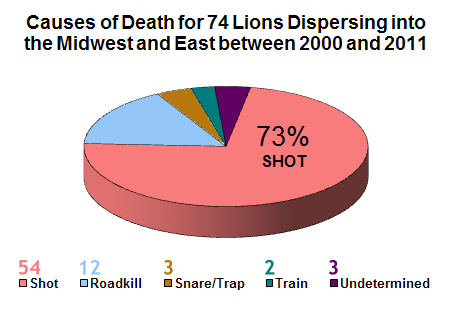
For example, wildlife officials in four states found and confirmed evidence of mountain lions that all traced back — through DNA analysis — to a single cat that was ultimately killed by an automobile in Connecticut. One of those states, Wisconsin, has now attributed 12 different sightings to that lion.
In Cougar Rewilding Foundation’s report, researchers eliminated all identified duplicate records and narrowed their list of potential lions down to 76 over a twelve-and-a-half year period.
Of the 76 lions that were actually confirmed to have entered the Midwest, all were killed except two that were captured and held in captivity. None survived to establish a territory in the wild.
The overwhelming majority of sighted lions are young transient males and not breeding pairs.
Finding at least one mate and establishing a resident territory is the end goal of any dispersal. Most female lions establish home ranges within fifty miles of their mother’s territory. Although males will disperse further, little or no progress is made toward establishing new breeding populations unless females are also found. The appearance of females well outside the species’ current range often takes decades.

Only twelve females have been documented making the long dispersal into uncharted portions of the Midwest, averaging only one to two per year over the eleven year analysis period. None of them appeared to cross paths with dispersing males before meeting their untimely deaths.
The tediously slow migration of individual females moving east means that it takes many generations for lions to expand the range of their breeding populations even when individual males have wandered thousands of miles away. Neither males nor females will stop to establish a home range without the presence of possible mates. So ultimately, for a new breeding population to start, a male and female — who have dispersed separately from the west — must randomly stumble upon each other in the two-million square miles of habitat east of their range. These random bets on exact location and timing, repeated over and over, represent the lion’s only chance for survival.
To make recolonization even less likely, the Midwest’s prairie country is not prime lion habitat. Even given the very best of conditions, only a tiny number of cats could potentially establish large home ranges sparsely across the landscape. Lions prefer areas with denser cover. But mountain lions can and will use the prairies’ open spaces and river corridors as highways to travel to better habitats further east.
Experts agree that the preponderance of young male lions traveling record distances is an indication of the lack of females across the landscapes they are traversing. This may very likely be the result of excessive trophy hunting and an overkill of females.
Basically what is happening is that after being kicked out of the den by their mothers, a few young dispersing males head off in an easterly direction from places like the Black Hills of South Dakota. In their travels, they come across habitat which in a normal situation would be highly suitable (appropriate vegetation, plenty of prey species (deer) and no mature males to fight), but lacking in the one factor that would convince them to stop their search — a mate. So they keep on moving, usually in the general in which direction they started.
Mountain lions are not necessarily using the most obvious wildlife corridors to reach a particular destination.
Of course, dispersing lions can’t know which is the best path to take. They have no roadmaps and no scouts reporting back on conditions ahead. Transient lions may start out in one direction, but the presence of insurmountable obstacles (intransigent males, impassable highways, sprawling subdivisions, suppressive human actions) may lead them elsewhere or even stop them dead.
Dr. Nielsen’s work has provided lion researchers with a good map of important wildlife corridors that could be used by lions and other wildlife and should be protected, but sometimes the above mentioned obstacles work to prevent young lions from even starting down those wildlife roads.
Both landscape and population genetics are important factors for helping us better understand wildlife movement and health. But unfortunately, genetic analysis cannot reveal which habitat corridors the lions actually used. It only tells us which western population they are closely related to. That is why it is critical to not only maintain as many dispersal avenues as possible, but to also allow as many origination points as well. For example, Dr. Nielsen’s researchindicated that mountain lions arriving in Missouri most likely traveled established corridors from Texas, but genetic evidence proved otherwise.
So that begs the question: what happened to stop lions from dispersing out of Texas? Are the policies that regulate the species in that state so excessive that local lions are having a hard enough time just back-filling newly opened territories and do not have sufficient population numbers to expand the species’ range? Or is something else killing them off en route?
The natural return of lions to their historic range is threatened by human policies.
Recent research has shown that human interaction — changes in habitat and hunting/eradication policies — is a major factor in the ability of Puma concolorto reestablish historic territories. Conditions of just a few decades ago which helped the species recover from the effects of human persecution have changed to the point where it is no longer a question as to whether expansion will continue, but rather whether survival at the origination point is even possible.
Take for example the geographic region known as the Black Hills. This island of lion habitat encompasses just over 5,000 square miles and touches on three separate states—Nebraska, South Dakota, and Wyoming. Up until 2005, Mountain lions were protected as an “endangered species” in South Dakota where most of the Black Hills is located. This benign policy allowed the species not only to grow within that state’s boundaries but over the years, to send out a small number of “colonists” eastward.
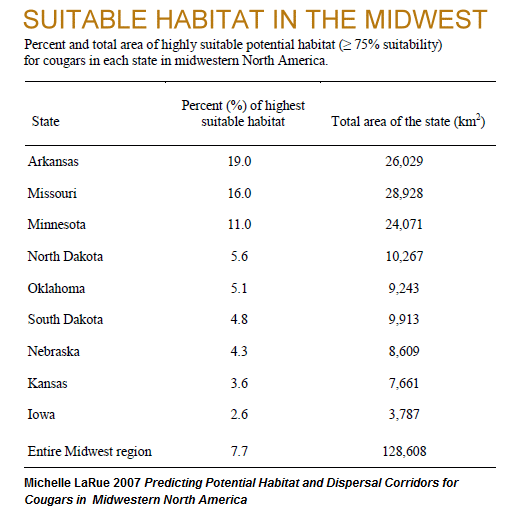
But that has all changed. Excessive hunting quotas, coupled with members of the state game commission that apparently want to eradicate the species, have created a situation where South Dakota’s resident lion population and its migrant males have been devastated. What’s more, Wyoming has decided to follow South Dakota’s lead by increasing the hunting quota of lions in their small portion of the Black Hills, and Nebraska has just announced its plans to start up a lion hunting season of its own as well.
What was once the greatest promise as a source for a return of breeding lion populations to the Midwest is now being turned into a graveyard of dreams.
And what about those Midwestern states that would be the recipients of this eastward migration of a formally extirpated species? As mentioned above Nebraska, the closest “prairie” state to the breeding source in South Dakota, decided to greet its new residents with a hunting season. In both Kansas and Missouri, legislation was introduced to allow people to kill these magnificent creatures on sight. One Missouri legislator even went so far as to call them an “invasive species.”
Unfortunately, lions aren’t safe even in those Midwestern states that aren’t actively trying to kill them. A couple years ago when the first lion in over a hundred years wandered back into Iowa, it was killed by a deer hunter after he discovered that there was no state law prohibiting that action (read Mountain Lion Shot Near Marengo for more details).
The Mountain Lion’s Return to the East:
Possible, But Not Assured
The natural return of the American lion to portions of its historic range has long been noticed by the public and now verified by science. But that isn’t enough. Three simple actions still need to occur for the eastern migration of mountain lions to become reality.
First, key population cores along the eastern edge of the species’ current range (such as the Black Hills region) need to be protected from local policies and actions that would eliminate them as national source populations or “breeding colonies.” No matter what members of state game commissions might think, a majority of lions live and breed on federal lands and subsequently belong to all Americans. These animals are supposed to be managed under the public trust doctrine—and killing them off for fun or to satisfy small special interest groups doesn’t fit that definition.
Second, critical wildlife corridors — least-cost pathways — all the way from the Rockies to the eastern seaboard (not just to the Mississippi River) need to be identified, protected, and if necessary, enhanced to support future migrations when the core populations have recovered sufficiently to use them. In addition, large tracts of land on the east coast, especially along the Appalachian Mountains, need to be conserved to ensure that dispersing lions have somewhere to establish large home ranges.
Third, protective legislation needs to be enacted now in those states which do not yet have viable lion populations. This is too important an issue to leave until the last minute, where a knee-jerk reaction on the part of policy makers might prevent the reestablishment of the species. Take Missouri for example. Up until just a few years ago, mountain lions were on that state’s endangered species list. Then in 2006, based on unfounded concerns from cattle ranchers, the Missouri Department of Conservation (MDC) Commission announced it was “…undesirable to have a breeding population of mountain lions in Missouri […] therefore, the Department of Conservation will not encourage the species to reestablish itself in the state.” This decision removed the mountain lion from the state’s endangered species list and reclassified it as “extirpated,” meaning extinct (or no local breeding population) in a particular area. Because of the irrational fear of what could happen and misinformation about the species, the mountain lion is no longer protected in Missouri.
The return of the American lion to Kansas, Missouri, Nebraska, and even Iowa should be a sign of vindication for the modern environmental movement. Instead, it now appears to possibly be a frustrating taunt of what could have been. The eastern migration and natural resettlement of long lost territories rests on the edge of a knife. Mountain lions have proven that if left alone, they can recover from over 200 years of persecution. It is now time for all Americans to let their voices be heard and allow this natural progression take place.
No Matter Where You Live:
Here’s What You Can Do to Help
Give a voice to the American lion in your state no matter what state you live in. If we’ve learned just one thing from the new research, it’s that action is never too soon or too late.
In your own words, illustrate the value of mountain lions, the threats they face, and why you hope to see them survive someday on your local landscape. Be exuberant! Now’s the time to extend protection to the mountain lion across the nation! And now’s the time for YOU to:
- Write letters to your local officials, state legislators and governor, as well as to your Congressperson and U.S. Senator (Click here to look up the contact info of your elected officials).
- Write letters to the editor of your local newspapers, particularly those which cover lion news stories. Comment on the websites of local television and radio stations that cover stories about wildlife.
- Support the scientific efforts to map wildlife corridors in your state, preserve the corridors intact, and be proactive to bypass any roadblocks.
- Support local, statewide, and national efforts to preserve deer and mountain lion habitat. (Read our feature on Western Wildways, a large scale attempt to map North American wildlife corridors.)
- Become a local lion activist and MLF volunteer. Recent experiences in Missouri demonstrate how just a few people can make a big difference.
- Keep up to date with ongoing scientific research and news stories about mountain lions by signing up for MLF’s updates.
- Become a Member of MLF by donating any amount to the Mountain Lion Foundation. Help create a critical mass of MLF membership in your state so the Foundation can speak with authority when it demands protections for lions.
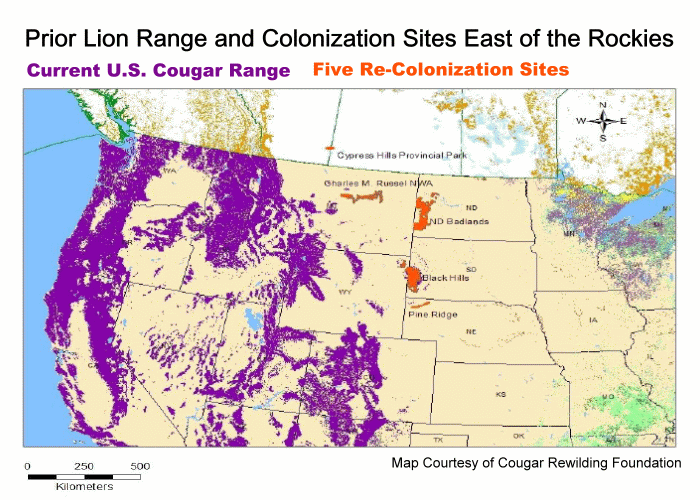



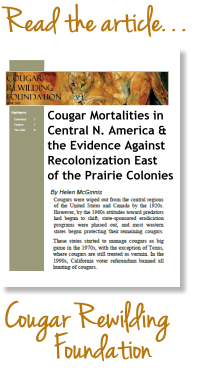

 Facebook
Facebook Twitter
Twitter Send Email
Send Email